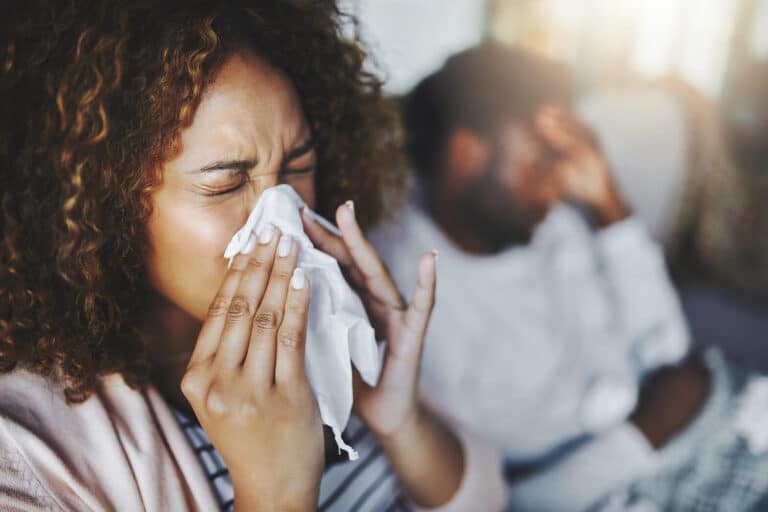According to the World Health Organization (WHO), asthma affects an estimated 300 million people worldwide. To anyone who has asthma, the feeling of a coming attack is unmissable. Modern medicine has already uncovered various aspects of this condition, like how to diagnose and treat it, but many factors, like what causes asthma, remain vague. Here are some things you probably didn’t know about asthma.
Understanding Asthma and the Symptoms
Asthma is a major non-communicable disease (NCD) and long-term condition that affects both children and adults. Inflammation and tightening of the muscles around small airways cause the air passages in the lungs to narrow.
While symptoms vary from person to person, the following are the most common:
- Shortness of breath
- Chest tightness or pain
- Wheezing when exhaling (a common sign of asthma in children)
- Coughing or wheezing attacks
Symptoms are intermittent and are often worse during exercise or at night, and common “triggers” can worsen symptoms too. But let’s get into the things you didn’t know about asthma.
12 Things You Didn’t Know About Asthma
1. Yawning Is a Symptom
One of the most common asthma symptoms is wheezing and then a non-productive dry cough. But did you know that yawning is a common sign of this condition? Because asthma essentially causes an oxygen deficiency in your body, it results in less oxygen getting into your system, which causes your body to induce yawning to cope.
2. Fatigue And Asthma Go Hand In Hand
Many people tend to avoid strenuous physical activity because it can trigger an asthma attack – more on that later. But it’s not uncommon for people who have asthma to feel very tired, even if they haven’t done much to overexert themselves. It’s not due to laziness; it’s because the body is working extra hard to oxygenate the rest of the cells with a limited supply. Your body is literally using up more energy than an average person, even while at rest, just to keep the body oxygenated.
3. Asthma Triggers Are Everywhere
While asthma triggers – much like symptoms – vary from person to person, there are a handful of common triggers. To manage their symptoms, doctors often advise asthma patients to avoid exposure to their known triggers whenever possible. Some common asthma triggers include irritants and allergens like dust, tobacco smoke, car exhaust fumes, mold, pet dander, and even smoke from burning wood. Non-environmental triggers such as colds, flu, sinus infections, acid reflux, and hyperventilation caused by stress, are harder to avoid.
4. Exercise Shouldn’t Be Avoided
If there’s one asthma trigger patients shouldn’t avoid, it’s physical activity. Yes, it does induce fast breathing, which can provoke asthma attacks – there’s even a type of asthma related to it (which we’ll get to later). But the health implications of living an inactive lifestyle outweigh those of exercising carefully, even with asthma. Instead of forgoing cardio exercise, doctors usually work with patients to develop a safe exercise plan. This might include doing warm-up intervals and using an inhaler before working out, wearing masks to limit exposure to irritants, and performing cool-down activities afterward.
5. Asthma Attacks Are Linked To Allergies
Just like when someone has a sneezing fit during pollen season, an asthma attack is similar. But while the former is irritating, the latter causes potentially life-threatening symptoms. When people with allergies are exposed to allergens like pollen, they produce antibodies that bind to that allergen, which signals the body to release chemicals that cause allergic-like reactions. In most people, symptoms are limited to the head, like a runny nose or watery eyes. However, in people who have asthma, the symptoms are felt in the lungs. If the lungs are inflamed, the airways swell up and fill with mucus, constricting airflow, and triggering asthma symptoms. Asthma attacks like this can be fatal when patients can’t get enough air to their lungs.
6. Asthma Is Easy To Diagnose
Surprisingly easy, in fact. The simplest way to diagnose asthma is through a lung function test. If someone is suffering from asthma-like symptoms (coughing, wheezing, chest tightness), a doctor will likely examine the strength of the patient’s exhalations – before and after having them use an inhaler. If their breathing improves after the medicine, it is likely the patient has asthma. Chest x-rays can also be used to diagnose asthma.

Related Read: Can Antibiotics Make Me Tired?
7. Asthma Might Be Hereditary
While doctors still aren’t entirely sure what causes asthma, they know it often runs in families. A 2010 study discovered that people with one parent with asthma were nearly twice as likely to have the condition themselves. People with a parent and a grandparent with asthma were four times more likely to develop it. Since asthma is connected to allergies, a genetic disposition toward allergies, called atopy, may explain some inherited asthma cases.
8. Asthma Is Most Common Among Children
Asthma is a common chronic disease, which according to the Asthma and Allergy Foundation of America, affects nearly 25 million in the United States alone, and children make up 7 million. Most people who suffer from asthma develop it during childhood. It is the leading chronic disease among children, and each year, students in the United States miss approximately 13.8 million school days because of it.
In addition, data from the CDC reveals that Hispanics are one of the most affected groups hit by asthma in the United States, which is attributed to 80% of the Hispanic population living in areas that don’t meet air pollution standards.
9. Germs May Help Your Child Beat The Asthma Odds
Much of whether a person develops asthma has to do with their environment early in life. So, people are less likely to have asthma if they grew up in rural areas, around animals, and in large families, as opposed to those who did not. We might have the hygiene hypothesis to thank for that. According to the hygiene hypothesis, kids who were exposed to germs and pathogens while their immune systems were still developing are better armed against allergens and less likely to have asthma. While children who were possibly sheltered from germs might be more likely to have an extreme immune response to harmless substances – in the case of asthma, potentially deadly. However, this hasn’t been proven and shouldn’t be cause for intentionally exposing children to infections in an attempt to strengthen them.
10. Asthma Affects Women (& Boys) More
There’s no denying that everybody can be affected by asthma. Some studies have found that, in childhood, boys are twice as likely to have asthma. But once they hit puberty, those scales tip. And, on top of being more commonly diagnosed in women, asthma symptoms also tend to be more extreme. Scientists believe it’s because ovarian hormones increase airway inflammation, while an increase in testosterone decreases it.
11. There Are Two Types Of Asthma Treatments
Two kinds of medications used to treat asthma are long-term controllers and quick-relievers. Immediate medicines like short-acting beta-agonists and anticholinergics relax muscles in the airways when flare-ups happen – they’re typically inhaled directly into the lungs with an inhaler.
Long-term treatments keep asthma symptoms under control over time and are taken as often as every day, regardless of whether symptoms arise. These include inhaled long-acting beta-agonists and corticosteroids, biologic injections, and theophylline and leukotriene modifier pills and liquids. All of these keep asthma symptoms at bay by relaxing muscles, reducing swelling, or preventing inflammation in the ways.
Related Read: Are Ear Infections Contagious?
12. Asthma Symptoms Can Lessen With Time
The disease is treatable; however, there’s no cure for asthma. But some patients do seem to grow out of it after suffering from it during childhood. It is entirely possible for symptoms to become less severe and go into remission as patients get older. Still, once a patient is diagnosed with asthma, the risk of an attack never completely goes away. Changes in hormone levels factor into why asthma symptoms come back in patients who haven’t experienced an attack in years.

Types of Asthma
There are actually 8 main types of asthma, each with its own causes. Let’s take a look at them.
- Allergic (Extrinsic) Asthma: This type of asthma is triggered by things like pollen, dust mites, pet dander, or mold. It’s also often associated with other allergic conditions such as hay fever and eczema.
- Non-Allergic (Intrinsic) Asthma: Intrinsic astma is triggered by things that aren’t related to allergies. This includes factors like stress, exercise, viral infections, and smoke.
- Exercise-Induced Asthma (EIA): Also known as Exercise-Induced Bronchoconstriction (EIB), this type of asthma is triggered by physical activity like heavy exercise.
- Occupational Asthma: Occupational asthma is triggered by things in the workplace, like chemicals, dust, and fumes.
- Cough-Variant Asthma: Cough-variant asthma is characterized by a cough that won’t go away, and doesn’t have the usual wheezing and shortness of breath associated with classic asthma.
- Nocturnal Asthma: This type of asthma worsens at night. This could be due to cooler air, natural body rhyhms, or even just lying down.
- Aspirin-Exacerbated Respiratory Disease (AERD): Also known as Aspirin-Induced Asthma (AIA), AERD is triggered by aspiring and other non-steroidal anti-inflammatories. It’s also associated with nasal polyps and chronic sinusitis.
- Adult-Onset Asthma: The last type of asthma on this list develops in adulthood, and usually has more severe symptoms and different triggers when compared to childhood asthma.
When To See A Doctor About Asthma
People suffering from asthma should visit their healthcare provider at least once a year – more often if experiencing symptoms. Even well-managed asthma can sometimes get out of control. Here are some guidelines on when you should get extra help.
Contact your healthcare provider immediately if:
- You have a cough that won’t go away
- You feel faint, dizzy or weak
- You have trouble doing a routine activity, like cooking dinner, cleaning or taking out the trash
- You wheeze when you breathe in or out, especially if this is different from your usual breathing pattern
- Your wheezing gets worse even after you’ve allowed your medicine time to work – most quick-relief medicines work within 15 minutes
Seek urgent care, go to the emergency room, or call 911 right away when:
- Your nostrils are flaring each time you breathe in
- The skin between your ribs or at the base of your throat appears stretched every time you breathe in
- You take 30 or more breaths per minute
- Your lips or nails are turning blue
- It’s difficult for you to talk or walk at a normal pace
What Happens During Asthma Testing and Diagnosis
Typically, asthma can be diagnosed using your symptoms and some simple tests. A GP is normally able to diagnose the condition, but they may also refer you to a specialist if they’re not sure.
A GP may ask:
- What symptoms you have
- When they happen and how often
- If anything seems to trigger them
- If you have conditions such as eczema or allergies, or a family history of them
A GP may suggest doing some tests to confirm if you have asthma. These tests are not easy for young children though, so your child may be given an asthma inhaler to see if it helps relieve their symptoms until they’re old enough to have the tests.
Tests for Asthma
The main tests used to help diagnose asthma are:
- FeNO test – where you breathe into a machine that measures the level of nitric oxide in your breath – a sign of inflammation in your lungs
- Spirometry – where you blow into a machine that measures how fast you can breathe out and how much air you can hold in your lungs
- Peak flow test – where you blow into a handheld device that measures how fast you can breathe out, and this may be done several times over a few weeks to see if it changes over time
After you’re diagnosed with asthma, you may also have a chest x-ray or allergy tests to see if your symptoms might be triggered by an allergy.
Use Air Doctor If You Need A Doctor Abroad
If you weren’t quite sure whether you have asthma, these things you didn’t know about asthma should give you a better idea of what steps you should take to lead a healthier lifestyle.
If you so have asthma and need to use an inhaler, you will be happy to know that telehealth doctors can prescribe inhaler refills. How to get an inhaler refill: Chat to one of our professional doctors and get the appropriate medical help you need.
Just use the Air Doctor app to find one – anywhere, anytime.
Air Doctor gives you:
- Access to over 20,000 multi-lingual doctors worldwide
- Choice of clinic, at-home (hotel), and video visits
- Local, valid prescriptions through our cross-border services
- Quality medical care, including urgent visits
- 24/7 multi-lingual customer support
- Video consultation services in up to 21 languages
- Partnered with leading insurance providers
Download the app, just in case.












